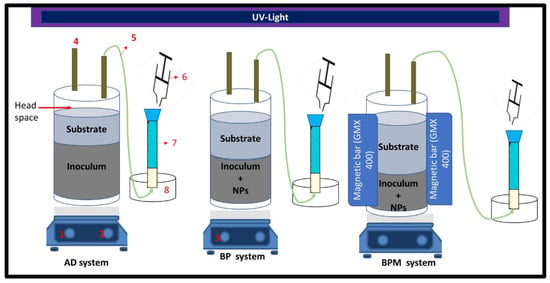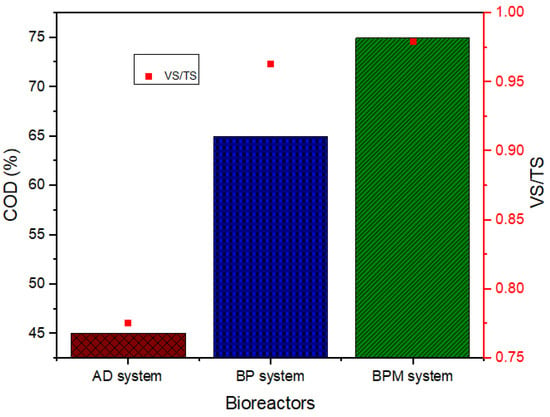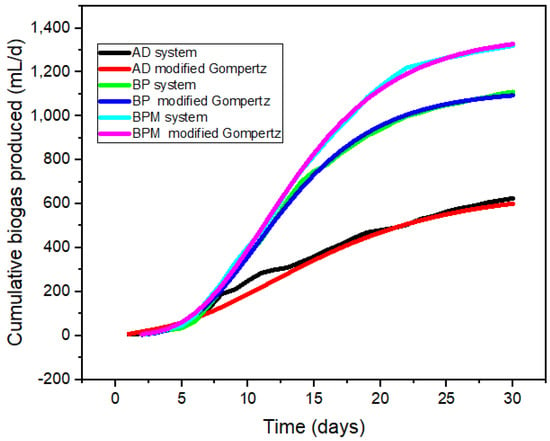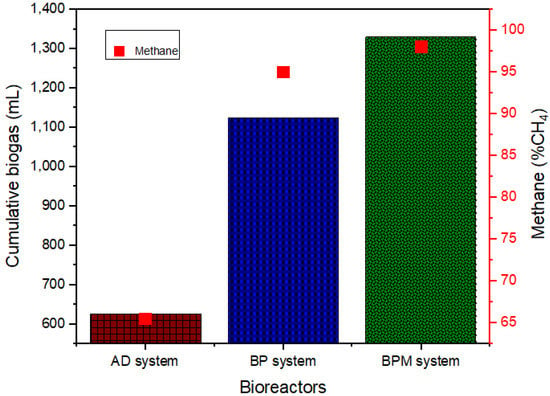Abstract
Carbon dioxide (CO2) emissions from fossil fuels have led industries to seek cheaper carbon abatement technologies to mitigate environmental pollution. Herein, the effect of a magnetic photocatalyst (Fe-TiO2) on biogas production in anaerobic digestion (AD) of wastewater was investigated with three bioreactors coupled with UV-light (18 W). Three experimental setups defined as the control (AD system with no Fe-TiO2), biophotoreactor (BP), and biophotomagnetic (BPM) systems were operated at a mesophilic temperature (35 ± 5 °C) for a hydraulic retention time (HRT) of 30 days. The control system (ADs) had no Fe-TiO2 additives. The BPMs with 2 g Fe-TiO2 were exposed to a magnetic field, whereas the BPs were not. The removal rate of the chemical oxygen demand (COD), volatile solids (VS), and total solids (TS), together with biogas production and composition were monitored for each reactor. The degree of degradation of 75% COD was observed for the BPMs at a pH of 6.5 followed by the BPs (65% COD) and the ADs (45% COD). The results showed that the rate of degradation of COD had a direct correlation with the cumulative biogas production of the BPMs (1330 mL/d) > BPs (1125 mL/d) > AD (625 mL/d). This finding supports the use of biophotomagnetic systems (BPMs) in wastewater treatment for resource recovery and CO2 reduction (0.64 kg CO2/L) as an eco-friendly technology.
1. Introduction
The development of zero waste technology and municipal waste management is critical for sustainable development, as CO2 emissions from fossil fuel combustion continue to be a global concern [,]. In essence, conventional energy sources such as natural gas, coal, and petroleum are continuously exploited. Due to the current overdependence on these fuel sources, which are depleting but have significant ecological impacts, there is a rising need for alternative fuels []. Furthermore, anthropogenic CO2 emissions, which contribute to global warming and climate change, have prompted the globe to seek out alternate actions to mitigate or control CO2 emissions []. The wastewater treatment settings cannot be overlooked in this regard, particularly considering the prospect of boosting its circular economy [,,,,]. Herein, energy-saving wastewater treatment systems have become essential, especially with the upgradation of biogas produced by anaerobic digesters (ADs).
Anaerobic digestion (AD) is a technique that transforms organic matter in biomass resources into biogas with methane (CH4) as a source of sustainable energy [,,]. Of essence, AD creates economic opportunities by producing bioenergy (60–70% methane) and stabilized digestate under suitable conditions to ease pollution []. The AD process utilises microorganisms’ degradation potential in an ecologically responsible, odour-reducing, and pathogenic organism-degrading mode, particularly in bioreactors operating at temperatures within the mesophilic (25–45 °C) or thermophilic (>45 °C) ranges [,,]. Additionally, produced biogas frequently contains pollutants such as H2S and CO2, which reduce the calorific value of the biogas and corrode equipment such as pipelines and incineration engines [,]. Co-digestion, pre-treatment, reactor design, and additives to stimulate bacteria growth and prevent inhibitory effects are some of the strategies utilized to address this [,,,]. In this study, the concept of photoreduction of CO2, which involves the conversion of the non-energy-rich component of the biogas into methane, is highlighted [].
In essence, biogas has been exploited as an alternative to fossil fuel for energy generation, and the concept of reducing the CO2 component to methane is limited. Biogas produced via anaerobic digestion of organic waste is composed of 55–65% methane and 35–45% CO2 and other gases such as H2S []. To solve the shortcomings, several abatement solutions have been proposed, whereby the AD process coupled with CO2 photoreduction is gaining attention [,,]. This technology involves the use of a photocatalyst in the presence of UV-light, visible light, or sunlight to convert the CO2 to methane, which is rich in energy [,]. In photocatalytic CO2 reduction, an incident light (UV, visible light, or sunshine) activates the photocatalyst surface. In doing so, it causes the electrons to shift from the valence band to the conduction band to form a hole and produce electrons [,]. The water molecules divide into hydroxyl and hydrogen ions, which then react with the released electron species. For example, CO2 generated from fossil fuel combustion is absorbed and converted to energy-rich methane by catalytic electrolysis []. Subsequently, the addition of nanoparticles to the AD process to enhance biogas production has gained attention [,].
Therefore, a biophotocatalytic reduction of CO2 produced anaerobically into methane by the seeding of a magnetic photocatalyst is shown in this study (Fe-TiO2). Three distinct configuration systems were explored in this study for reducing sugar refinery wastewater contamination, biogas generation, and methane yield, as well as reducing CO2 emissions. The modified Gompertz model was utilised to establish the model’s operational variables kinematically.
2. Materials and Methods
2.1. Wastewater and Activated Sludge
In this study, The wastewater samples were taken from the biofiltration stream that goes into a bio-digester and clarifier at a sugar refinery wastewater treatment plant in Durban, KwaZulu–Natal, South Africa. This sample point (Figure 1) had a mixture of dewatered centrate with less than 5% solids and biofiltration effluent. The supernatant was employed as substrate in this experiment, whereas the digested sludge was used as inoculum. The magnetite photocatalyst (Fe-TiO2 NPs) used was engineered and characterised at a high magnification of 10–50 kx and landing energy capacity of 20 keV and, as depicted in our previous studies [], had a surface and average crystallite size of 6.5 mm and 20 µm [,]. Characteristics of the wastewater sample is presented in Table 1.

Figure 1.
Block diagram of a sugar refinery wastewater treatment plant, Kwazulu Natal, South Afrca.

Table 1.
Composition of wastewater sample.
2.2. Experimental Setup
Experimental setup protocols were adapted from Kweinor Tetteh and Rathilal [] and Tetteh and Rathilal []. Figure 2 presents the experimental setup employed in this study. Three 1-L Duran Schott bottles used as bioreactors were coupled with UV-light (T8 blacklight-blue bulbs 400 nm, Philips, Netherland), a hotplate magnetic stirrer (temperature regulator), and biogas collection system. Each duplicated reactor was charged with 80% working volume of inoculum to substrate ratio of 3:5 seeded with or without a magnetic photocatalyst of 2 g of Fe-TiO2 NPs. Herein, these bioreactors, defined as control (AD system with no NPs), biophotoreactor (BP system with NPs) and biophotomagnetic (BPM system with NPs), were operated at a hydraulic retention time (HRT) of 30 days at a temperature of 40 °C and intermittent mixing at 15 rpm. Two magnetic bars (GMX model 400) used on the BPM system was obtained from Chino, California, USA. The daily biogas was monitored by downward displacement techniques, while its composition was characterised by Gas Chromatography (GC 2014, Shimadzu). The degree of efficiency of the contaminant removal and the modified Gompertz kinetic model for the biogas production were respectively estimated by Equations (1) and (2).
where, = Substrate influent and = Substrate effluent. The cumulative biogas production data obtained were evaluated by the modified Gompertz Equation (2) [,].
where, = cumulative specific biomethane (mL/g COD) at time (days), = the methane potential (mL/g COD), = lag phase of producing biogas (day), Ce = mathematical constant (2.718282), = the maximum specific substrate uptake rate per maximum biogas produced (/g COD.day) and is the methane production rate constant (1/d), expressed as .

Figure 2.
1: Temperature controller; 2: mixing controller; 3: hotplate magnetic stirrer; 4: purging port; 5: silicon tube; 6: gas sampler; 7: water displacement gas collector; 8: water trough.
3. Results
The magnetic field and photocatalyst (Fe-TiO2) influence on the BPs and BPMs were compared with a control AD system for the degradation of the organic matter (COD), biogas production and methanation (biogas enhancement). Among these bioreactors is the biophotomagnetic (BPM) system, whose efficiency supersedes that of the BP and AD systems. Table 2 presents the comparative summary of results obtained after the 30-day incubation of the three bioreactors by monitoring the degree of degradation in terms of COD reduction to ascertain the treatability performance. Evidently, the rate of degrading the solid content of the wastewater, as revealed by the VS/TS ratio, contributed to the COD reduction (Figure 3). The cumulative biogas data (Figure 4) were also fitted on the Gompertz kinetic model (2), whereby the kinetic conditions obtained are presented in Table 3. Moreover, each bioreactor system achieved distinctive potential for the carbon-based content of the biogas produced and methane yield (Figure 5).

Table 2.
Summary of bioreactor performance after 30 days of incubation.

Figure 3.
Bioreactor performance for COD removal (%) and VS/TS reduction ratio after 30 days of incubation.

Figure 4.
Bioreactor cumulative biogas production fitted with modified Gompertz kinetic model for the 30-day incubation.

Table 3.
Summary of modified Gompertz kinetic model parameters.

Figure 5.
Bioreactor maximum cumulative biogas yield (mL) and methane composition (% CH4) after 30 days of incubation.
4. Discussion
In this section, the wastewater degradation efficiency, the biogas produced and composition as well as the estimated energy produced, and the CO2 emission reduction are discussed.
4.1. Degradation of the Organics
The Fe-TiO2 additions in the BP and BPM systems increased the degradability activity as shown with an increase in the COD removal (Figure 3). Evidently, the anaerobic hydrolysis and methanogenesis were thermodynamically favoured when Fe-TiO2 was magnetically seeded with electron donors (Fe, OH, H, and Ti species) [,]. This electroreceptive reaction expressed in Equations (3) and (4), demonstrated the release of the Fe3+ species in the bioreactors facilitated the sulphur-reducing microbes [,].
Fe + 2H2O → Fe (OH)2 + H2
4Fe + SO2 + 4H2O → 3Fe(OH)2 + FeS + 2OH−
According to Ajay et al. [], the aggregation of trace metals is responsible for the acidification or alkalinity surge in the reactor system. The microbial activity in the system indicates metal imbalance despite the nutritional benefits of most metals [,,]. This shows that bioavailability of metal species for microbial uptake in the reactors (AD alone, BM, and BPM) may vary based on chemical and biological circumstances. Thus, improving the reactor requires metals as macro or micronutrients for microbial metabolic enzymatic activities and growth. The nutritional balance aided substrate breakdown and biogas production [,,].
4.2. Biogas Production
Generally, biogas constituting hydrogen (H2), methane (CH4), and carbon dioxide (CO2) are the biologically digester end-products of the wastewater substrates. In essence, reducing the CO2 content into a more ecofriendly gas involves a series of mechanism [,]. The methanation reaction between the CO2 and H2, was being influenced by the Fe-TiO2 induced with the activated energy of the UV-light. Herein, the hydrogenation process or hydrolysis of the water molecules splitting (H2 and O2) was being ignited by coupled photocatalysis []. In addition, the incorporation of the magnetic field influenced the agglomeration of the action of the hydrogenotrophic methanogens in conversion of the CO2 into methane []. This reaction mechanism is expressed in Equation (5).
Figure 4 shows the cumulative biogas production volume at different levels of the three bioreactors operated at the same conditions for 30 days. The maximum cumulative biogas estimated for the biogas produced by the bioreactors (BP = 1125 mL; BPM = 1330 mL) with the Fe-TiO2 additives were found to be significantly different from that of the control (AD = 625 mL). The BPM system, where 2 g of Fe-TiO2 additives was added on an average basis, was estimated to be 788 mL/d, followed by the BP system with 671 mL/d and the AD system with 345 mL/d. Kinetically, the cumulative data obtained were well-fitted on the modified Gompertz model (2), where the operating variables obtained are presented in Table 3. There exists a significant correlation (95% confidence level) between the degradation of the carbon content of the wastewater to biogas with a high regression coefficient (R2 > 0.9). These findings correlate with other studies, whereby the Fe-TiO2 additives increased the surface area of the sludge. This enhanced the microbial activity and hence resulted in high biogas production as compared to the AD system [,].
After the HRT of 30 days for methanogenesis, the biogas composition was characterised as showing a high methane yield greater than 65% in the increasing order of the systems as AD < BP < BPM. As shown in Figure 5, there was an impact in both the biogas and methane of the BP and BPM systems. There was partial degradation in the AD system, which is consistent with previous studies that showed the AD process to be kinetically unstable with a general methane potential of 50–65% [,,].
4.3. Energy Estimation and CO2 Reduction Estimation
The energy efficiency and environmental impact was estimated based on the conversion rate of the biomethane into electricity. This was estimated based on the assumed 78% of the energy produced (Table 2), where 33% was electricity generated from the biogas and 45% was generated from the heat in a cogeneration process. In Expression (6), for the electricity generated from the biomethane per unit effluent volume (kWh/m3), the is the total biogas generated [,].
Herein, CO2 emission reduction was therefore estimated as a function of the electricity produced to power the UV lamp of the photoreactors with respect to the base line grid emission factor of 0.957 kg CO2 e/kWh as given in Equation (7).
Generally, the bioconversion of carbon dioxide to methane of anthropogenic emission from wastewater treatment plants and landfill gases can necessitate the reduction in global warming [,,]. In this case, the maximum CO2 emission reduction (kg CO2) was estimated to be 0.640 kg CO2/L for the BPM system with the rest depicted in Table 2.
Therefore, the BPM system has shown great potential in significantly contributing to decreasing greenhouse gas emissions and mitigating unusual climate change. Additionally, the abatement of greenhouse effects in the wastewater settings can easily be managed with less effort as compared to petrochemical industries. Moreover, the wastewater from the sugar refinery used in this study constitute a high carbon content, which can be used by the BPM system to produce enough energy to offset the photoreactor. Furthermore, the magnetic field incorporated in the BPM, as reported in previous studies [], has the potential impact for recoverability of the magnetised photocatalyst for reuse. Hence, expanding this technology will also warrant reduction in operation costs such as the pressing cost of chemicals used in the wastewater settings.
5. Conclusions
This study presents a biophotomagnetic system as an energy-saving wastewater treatment option with the upgradation of biogas produced by anaerobic digesters. This study strengthened the knowledge of valorisation of sugar refinery wastewater anaerobically for biogas production and CO2 emission reduction via photoreduction. Three bioreactor configurations were investigated at the same conditions for 30 days. Among them, the biophotomagnetic (BPM) system seeded with Fe-TiO2 was found to be the most effective inherent to wastewater treatment (75% COD removal), biogas produced (13,330 mL), and methane yield (98% CH4) as compared to the ADs of 65.5% CH4. The good performance of the BPM system has been attributed to the biostimulation influence of the Fe-TiO2 additives ignited by the UV-light and the magnetic field. Cumulatively, the biogas data were well-fitted on a modified Gompertz kinetic model, and the operational variables defined were found to be significant (p < 0.05). It also revealed that the start-up and acclimatisation of the microbes in the BPM system was shorter (9 days; k = 0.19 d−1) as compared to the BP (10 days; k = 0.18 d−1) and AD (11 days; k = 0.13 d−1) processes. To offset the energy demand by the UV-light for the BPM system and environmental conservation, a CO2 emission reduction of 0.64 kg CO2 e/L was attained. Conclusively, the BPM system is foreseen to be an eco-friendly technology and therefore integrating its industrial applications must be given attention.
Author Contributions
Conceptualisation; E.K.T., investigation, methodology, and writing of the original draft preparation was carried out by E.K.T. and G.A.-D., whereas supervision, review and editing was carried out by S.R. All authors have read and agreed to the published version of the manuscript.
Funding
This research was funded by the Water Research Commission of South Africa under project identification WRC Project: C2019/2020-00212.
Institutional Review Board Statement
Not applicable.
Informed Consent Statement
Not applicable.
Data Availability Statement
Not applicable.
Acknowledgments
The authors wish to thank the Durban University of Technology, Green Engineering Research Group, and the Water Research Commission of South Africa for their support on the project identification WRC Project: C2019/2020-00212. The authors also wish to thank the National Research Foundation for their scholarship grant number 138046.
Conflicts of Interest
The authors declare no conflict of interest.
References
- Goswami, R.K.; Mehariya, S.; Obulisamy, P.K.; Verma, P. Advanced microalgae-based renewable biohydrogen production systems: A review. Bioresour. Technol. 2021, 320, 124301. [Google Scholar] [CrossRef] [PubMed]
- Spierling, S.; Röttger, C.; Venkatachalam, V.; Mudersbach, M.; Herrmann, C.; Endres, H.-J. Bio-based plastics-a building block for the circular economy? Procedia CIRP 2018, 69, 573–578. [Google Scholar] [CrossRef]
- Wang, W.-N.; Soulis, J.; Yang, Y.J.; Biswas, P. Comparison of CO2 Photoreduction Systems: A Review. Aerosol Air Qual. Res. 2014, 14, 533–549. [Google Scholar] [CrossRef]
- Wang, Z.-Y.; Chou, H.-C.; Wu, J.C.S.; Tsai, D.P.; Mul, G. CO2 photoreduction using NiO/InTaO4 in optical-fiber reactor for renewable energy. Appl. Catal. A Gen. 2010, 380, 172–177. [Google Scholar] [CrossRef]
- Tetteh, E.K.; Rathilal, S. Biogas production from wastewater treatment-evaluating anaerobic and biomagnetic systems. Water-Energy Nexus 2021, 4, 165–173. [Google Scholar] [CrossRef]
- Michailos, S.; Walker, M.; Moody, A.; Poggio, D.; Pourkashanian, M. Biomethane production using an integrated anaerobic digestion, gasification and CO2 biomethanation process in a real waste water treatment plant: A techno-economic assessment. Energy Convers. Manag. 2020, 209, 112663. [Google Scholar] [CrossRef]
- Tetteh, E.K.; Rathilal, S. Response Surface Optimization of Biophotocatalytic Degradation of Industrial Wastewater for Bioenergy Recovery. Bioengineering 2022, 9, 95. [Google Scholar] [CrossRef]
- Krümpel, J.; Schäufele, F.; Schneider, J.; Jungbluth, T.; Zielonka, S.; Lemmer, A. Kinetics of biogas production in anaerobic filters. Bioresour. Technol. 2016, 200, 230–234. [Google Scholar] [CrossRef] [PubMed]
- Stafford, W.; Cohen, B.; Pather-Elias, S.; von Blottnitz, H.; van Hille, R.; Harrison, S.T.L.; Burton, S.G. Technologies for recovery of energy from wastewaters: Applicability and potential in South Africa. J. Energy S. Afr. 2013, 24. Available online: http://www.scielo.org.za/scielo.php?script=sci_arttext&pid=S1021-447X2013000100003 (accessed on 8 May 2022). [CrossRef]
- Zhao, J.; Li, Y.; Dong, R. Recent progress towards in-situ biogas upgrading technologies. Sci. Total Environ. 2021, 800, 149667. [Google Scholar] [CrossRef] [PubMed]
- Tetteh, E.K.; Amo-Duodu, G.; Rathilal, S. Synergistic Effects of Magnetic Nanomaterials on Post-Digestate for Biogas Production. Molecules 2021, 26, 6434. [Google Scholar] [CrossRef]
- Nguyen, T.K.L.; Ngo, H.H.; Guo, W.; Nguyen, T.L.H.; Chang, S.W.; Nguyen, D.D.; Varjani, S.; Lei, Z.; Deng, L. Environmental impacts and greenhouse gas emissions assessment for energy recovery and material recycle of the wastewater treatment plant. Sci. Total Environ. 2021, 784, 147135. [Google Scholar] [CrossRef] [PubMed]
- Apollo, S.; Onyango, M.S.; Ochieng, A. An integrated anaerobic digestion and UV photocatalytic treatment of distillery wastewater. J. Hazard. Mater. 2013, 261, 435–442. [Google Scholar] [CrossRef]
- Durán, I.; Rubiera, F.; Pevida, C. Modeling a biogas upgrading PSA unit with a sustainable activated carbon derived from pine sawdust. Sensitivity analysis on the adsorption of CO2 and CH4 mixtures. Chem. Eng. J. 2021, 428, 132564. [Google Scholar] [CrossRef]
- Ángeles, R.; Vega-Quiel, M.J.; Batista, A.; Fernández-Ramos, O.; Lebrero, R.; Muñoz, R. Influence of biogas supply regime on photosynthetic biogas upgrading performance in an enclosed algal-bacterial photobioreactor. Algal Res. 2021, 57, 102350. [Google Scholar] [CrossRef]
- Deublein, D.; Steinhauser, A. Biogas from Waste and Renewable Resources: An Introduction; John Wiley & Sons: Hoboken, NJ, USA, 2011. [Google Scholar]
- Baniamer, M.; Aroujalian, A.; Sharifnia, S. Photocatalytic membrane reactor for simultaneous separation and photoreduction of CO2 to methanol. Int. J. Energy Res. 2021, 45, 2353–2366. [Google Scholar] [CrossRef]
- Ola, O.; Maroto-Valer, M.M. Review of material design and reactor engineering on TiO2 photocatalysis for CO2 reduction. J. Photochem. Photobiol. C Photochem. Rev. 2015, 24, 16–42. [Google Scholar] [CrossRef] [Green Version]
- Wu, J.; Lin, H.-M. Photo reduction of CO2 to methanol via TiO2 photocatalyst. Int. J. Photoenergy 2005, 7, 115–119. [Google Scholar] [CrossRef] [Green Version]
- Sharmila, V.G.; Banu, J.R.; Gunasekaran, M.; Angappane, S.; Yeom, I.T. Nano-layered TiO2 for effective bacterial disintegration of waste activated sludge and biogas production. J. Chem. Technol. Biotechnol. 2018, 93, 2701–2709. [Google Scholar] [CrossRef]
- Lee, S.-Y.; Park, S.-J. TiO2 photocatalyst for water treatment applications. J. Ind. Eng. Chem. 2013, 19, 1761–1769. [Google Scholar] [CrossRef]
- Esfandiari, N.; Kashefi, M.; Afsharnezhad, S.; Mirjalili, M. Insight into enhanced visible light photocatalytic activity of Fe3O4–SiO2–TiO2 core-multishell nanoparticles on the elimination of Escherichia coli. Mater. Chem. Phys. 2020, 244, 122633. [Google Scholar] [CrossRef]
- Kalan, R.E.; Yaparatne, S.; Amirbahman, A.; Tripp, C.P. P25 titanium dioxide coated magnetic particles: Preparation, characterization and photocatalytic activity. Appl. Catal. B Environ. 2016, 187, 249–258. [Google Scholar] [CrossRef]
- Tetteh, E.K.; Rathilal, S. Biophotocatalytic Reduction of CO2 in Anaerobic Biogas Produced from Wastewater Treatment Using an Integrated System. Catalysts 2020, 12, 76. [Google Scholar] [CrossRef]
- Gupta, S.M.; Tripathi, M. A review of TiO2 nanoparticles. Chin. Sci. Bull. 2011, 56, 1639–1657. [Google Scholar] [CrossRef] [Green Version]
- Ajay, C.; Mohan, S.; Dinesha, P.; Rosen, M.A. Review of impact of nanoparticle additives on anaerobic digestion and methane generation. Fuel 2020, 277, 118234. [Google Scholar] [CrossRef]
- Abdullah, H.; Khan, M.M.R.; Ong, H.R.; Yaakob, Z. Modified TiO2 photocatalyst for CO2 photocatalytic reduction: An overview. J. CO2 Util. 2017, 22, 15–32. [Google Scholar] [CrossRef]
- Abdelsalam, E.; Samer, M.; Attia, Y.; Abdel-Hadi, M.; Hassan, H.; Badr, Y. Comparison of nanoparticles effects on biogas and methane production from anaerobic digestion of cattle dung slurry. Renew. Energy 2016, 87, 592–598. [Google Scholar] [CrossRef]
- Xu, B.; Zada, A.; Wang, G.; Qu, Y. Boosting the visible-light photoactivities of BiVO4 nanoplates by Eu doping and coupling CeOx nanoparticles for CO2 reduction and organic oxidation. Sustain. Energy Fuels 2019, 3, 3363–3369. [Google Scholar] [CrossRef]
- Kweinor Tetteh, E.; Rathilal, S. Application of biomagnetic nanoparticles for biostimulation of biogas production from wastewater treatment. Mater. Today Proc. 2021, 45, 5214–5220. [Google Scholar] [CrossRef]
Publisher’s Note: MDPI stays neutral with regard to jurisdictional claims in published maps and institutional affiliations. |
© 2022 by the authors. Licensee MDPI, Basel, Switzerland. This article is an open access article distributed under the terms and conditions of the Creative Commons Attribution (CC BY) license (https://creativecommons.org/licenses/by/4.0/).